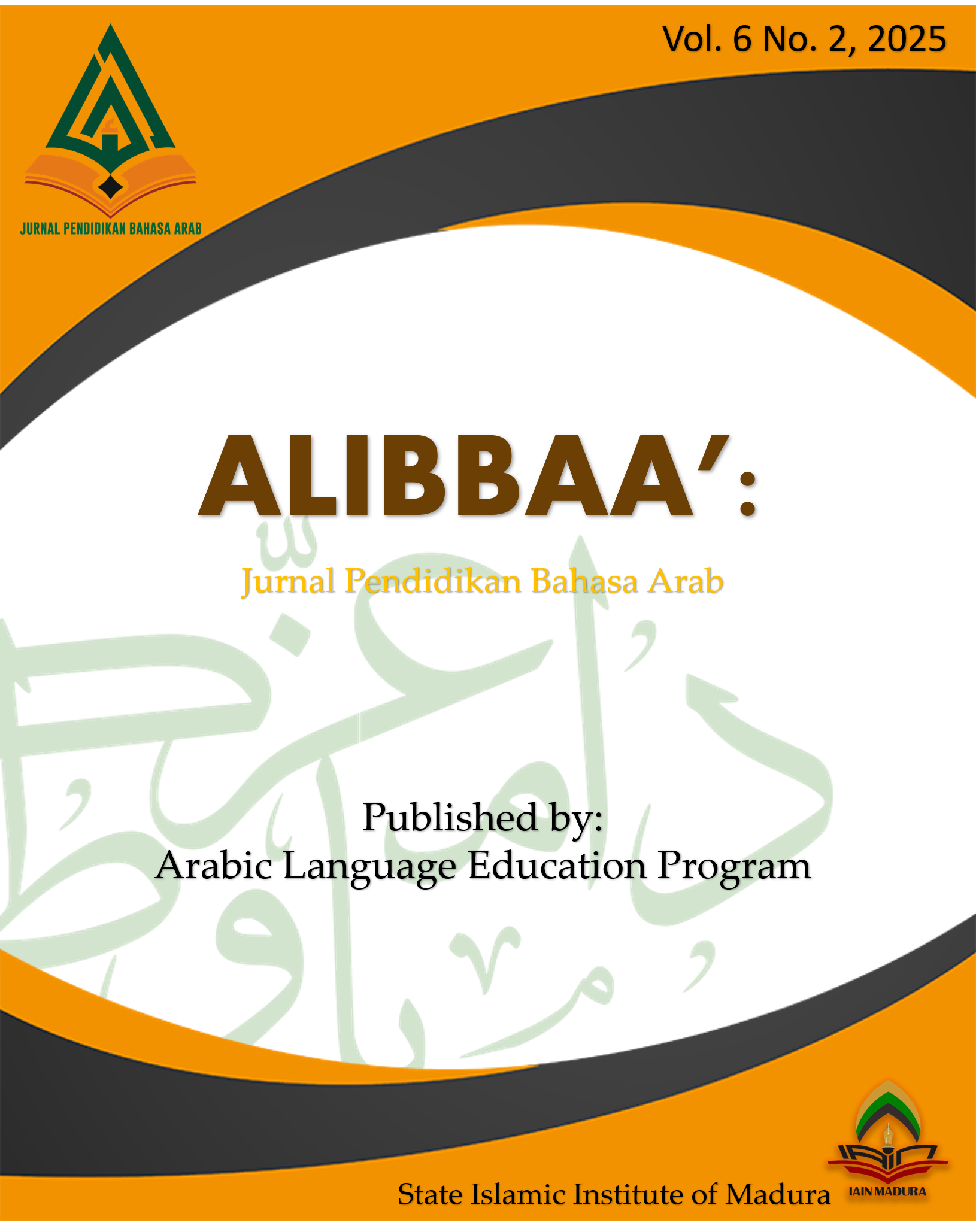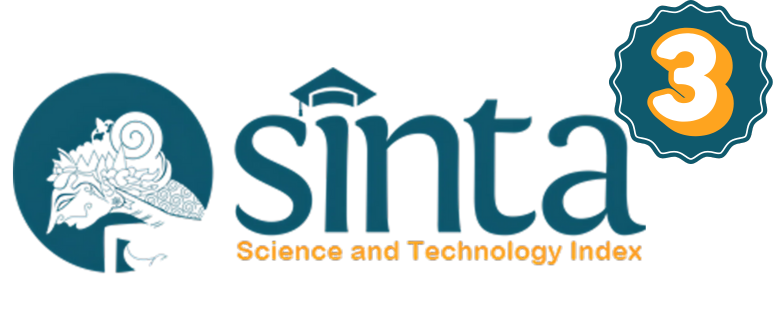Contextual Teaching and Learning in Arabic as a Foreign Language: A Classroom-Based Case Study in Indonesia
 Abstract views: 237
,
Abstract views: 237
,
 pdf downloads: 191
pdf downloads: 191
Abstract
This study aims to describe the implementation of the Contextual Teaching and Learning (CTL) approach in Arabic language instruction for seventh-grade students at MTs Ar-Ridho Medan, and to analyze the supporting and inhibiting factors during its implementation. Employing a qualitative approach with a case study design, the research explores pedagogical practices in authentic classroom settings through observation, semi-structured interviews, and documentation. The findings reveal that the teacher successfully integrated all seven core components of CTL (constructivism, inquiry, learning community, modeling, reflection, meaningful learning, and authentic assessment) into classroom practice. Students demonstrated high enthusiasm, active participation, and a contextual understanding of the material. Nevertheless, challenges such as limited instructional time, insufficient learning facilities, and diverse student characteristics require strategic management. This study offers both practical and theoretical contributions to the development of more meaningful Arabic language instruction models in Islamic schools.
Downloads
References
Afnita, Efrianto, Siti Ansoriyah, Fitriani Lubis, Ifnaldi, Zulfikarni, Jr., V. T. D., Mamat, S., Ulya, R. H., Rachman, A., and Nurrahmah, F. “Developing CTL-Based Digital Media E-Worksheet for Second Language Learning.” Forum for Linguistic Studies 7, no. 6 (2025). https://doi.org/10.30564/fls.v7i6.9665.
Alkhannani, B. M. “The Effectiveness of Collaborative Teaching and Learning and Engaging Students as Partners on English Language Teaching in Saudi Arabia.” Theory and Practice in Language Studies 11, no. 10 (2021): 1288–1294. https://doi.org/10.17507/tpls.1110.17.
Azzouz Boudadi, N., and Gutiérrez-Colón, M. “Effect of Gamification on Students’ Motivation and Learning Achievement in Second Language Acquisition within Higher Education: A Literature Review 2011–2019.” The EuroCALL Review 28, no. 1 (2020): 40. https://doi.org/10.4995/eurocall.2020.12974.
Dewi, I., Ahmad Nurcholis, Izzatul Laila, Juan Acevedo, and Moumen El-Sayed. “Curiosity-Driven Learning in Arabic: A Case Study on the ‘Inquiring Minds Want to Know’ Approach.” Alibbaa’: Jurnal Pendidikan Bahasa Arab 6, no. 1 (2025): 42–64. https://doi.org/10.19105/ajpba.v6i1.17881.
Elaine B. Johnson. Contextual Teaching and Learning: What It Is and Why It’s Here to Stay. Thousand Oaks, CA: Corwin Press, 2002.
Elnagar, A., Al-Debsi, R., and Einea, O. “Arabic Text Classification Using Deep Learning Models.” Information Processing & Management 57, no. 1 (2020): 102121. https://doi.org/10.1016/j.ipm.2019.102121.
Erbil, D. G. “A Review of Flipped Classroom and Cooperative Learning Method Within the Context of Vygotsky Theory.” Frontiers in Psychology 11 (2020). https://doi.org/10.3389/fpsyg.2020.01157.
Hadi, N., Alvina, N., and Khaled Radhouani. “Ta’zîzu Dâfi’iyyati Thullâbi Riyâdh al-Athfâl li Tathwîri Mahârât al-Lughah al-’Arabiyyah al-Syafawiyyah min Khilâli Barâmiji al-Ta’lîm al-Mukatstsaf.” Alibbaa’: Jurnal Pendidikan Bahasa Arab 5, no. 2 (2024): 189–214. https://doi.org/10.19105/ajpba.v5i2.12195.
Jamil, H., and Agung, N. “Tantangan Pembelajaran Bahasa Arab Di Era Society 5.0: Analisis Pembelajaran Bahasa Arab Berbasis Aplikasi Interaktif.” Alibbaa’: Jurnal Pendidikan Bahasa Arab 3, no. 1 (2022): 38–51. https://doi.org/10.19105/ajpba.v3i1.5536.
Johnson, Elaine B. Contextual Teaching and Learning: What It Is and Why It’s Here to Stay. Thousand Oaks, CA: Corwin Press, 2002.
Maimunah, I., Sutaman, S., Taufiqurrochman, R., Siregar, H. H., and Alaoui, M. M. I. “Synchronous Arabic Learning Based on Sociocultural Theory: New Trends in Arabic Learning at University.” Arabi: Journal of Arabic Studies 7, no. 2 (2022): 162–172. https://doi.org/10.24865/ajas.v7i2.480.
Matthew B. Miles, A. Michael Huberman, and Johnny Saldaña. Qualitative Data Analysis: A Methods Sourcebook. 3rd ed. Thousand Oaks, CA: SAGE Publications, 2014.
Sodiq, S., and Alindah, L. “The Hidden Indonesian Language Literacy Curriculum in Arabic Language Textbooks for Islamic Junior High School.” Ijaz Arabi Journal of Arabic Learning 7, no. 1 (2024). https://doi.org/10.18860/ijazarabi.v7i1.25049.
Syahputri, D. “Improving Students’ Achievement in Reading Comprehension by Applying Contextual Teaching and Learning (CTL).” Budapest International Research and Critics in Linguistics and Education (BirLE) Journal 2, no. 3 (2019): 58–69. https://doi.org/10.33258/birle.v2i3.361.
Tamam Syaifuddin, Luthfiyah Nurlaela, and Sukma Perdana P. “Contextual Teaching and Learning (CTL) Model to Students Improve Learning Outcome at Senior High School of Model Terpadu Bojonegoro.” IJORER: International Journal of Recent Educational Research 2, no. 5 (2021): 528–535. https://doi.org/10.46245/ijorer.v2i5.143.
Tari, D. K., and Rosana, D. “Contextual Teaching and Learning to Develop Critical Thinking and Practical Skills.” Journal of Physics: Conference Series 1233, no. 1 (2019): 012102. https://doi.org/10.1088/1742-6596/1233/1/012102.
Usman, H., et al. “English Language Book Reading Based on Contextual Teaching and Learning (CTL) for Elementary School Students.” Opcion 35, Special Issue 21 (2019): 2899–2917.
Yasin, B., Mustafa, F., Safina, D., Yusuf, Y., Khairuddin, K., and Sarinauli, B. “Introducing Contextual Teaching and Learning as a Transition from Textbook-Based Curriculum to the National Curriculum.” European Journal of Educational Research 12, no. 4 (2023): 1767–1779. https://doi.org/10.12973/eu-jer.12.4.1767.
Yin, Robert K. Case Study Research and Applications: Design and Methods. 6th ed. Thousand Oaks, CA: SAGE Publications, 2018.
Yulia, F., Ali Hasan, E. M. E., Bahri, A. N., Fiqiyah, M., and Taufiq, M. “Effectiveness of Instructional Communication of Mahārah Al-Kalām at Sultan Idris Education University.” Ta’lim al-’Arabiyyah: Jurnal Pendidikan Bahasa Arab & Kebahasaaraban 8, no. 2 (2024): 216–233. https://doi.org/10.15575/jpba.v8i2.39201.
Yeni Ghonivita, John Pahamzah, Syafrizal Syafrizal, and Murti Ayu Wijayanti. “Improving Students’ Listening Skill and Vocabulary Mastery through Contextual Teaching and Learning (CTL) by Using Online Learning for Senior High School.” International Journal of English Language and Linguistics Research 9, no. 4 (2021): 45–56.
Yonca Özkan and Arda Arikan. “The Use of Contextual Teaching and Learning (CTL) to Improve Students’ Communicative Competence in EFL Speaking Classes.” Journal of Language and Linguistic Studies 16, no. 2 (2020): 1035–1049.
Authors who publish with this journal agree to the following terms:
a. Authors retain copyright and grant the journal right of first publication with the work simultaneously licensed under a Creative Commons Attribution License that allows others to share the work with an acknowledgement of the work's authorship and initial publication in this journal.
b. Authors are able to enter into separate, additional contractual arrangements for the non-exclusive distribution of the journal's published version of the work (e.g., post it to an institutional repository or publish it in a book), with an acknowledgement of its initial publication in this journal.
c. Authors are permitted and encouraged to post their work online (e.g., in institutional repositories or on their website) prior to and during the submission process, as it can lead to productive exchanges, as well as earlier and greater citation of published work (See The Effect of Open Access).
Alibbaa': Jurnal Pendidikan Bahasa Arab have CC-BY-SA or an equivalent license as the optimal license for the publication, distribution, use, and reuse of scholarly work.
In developing strategy and setting priorities, Alibbaa': Jurnal Pendidikan Bahasa Arab recognize that free access is better than priced access, libre access is better than free access, and libre under CC-BY-SA or the equivalent is better than libre under more restrictive open licenses. We should achieve what we can when we can. We should not delay achieving free in order to achieve libre, and we should not stop with free when we can achieve libre.

Alibbaa': Jurnal Pendidikan Bahasa Arab is licensed under a Creative Commons Attribution 4.0 International License
You are free to:
- Share — copy and redistribute the material in any medium or format
- Adapt — remix, transform, and build upon the material for any purpose, even commercially.
- The licensor cannot revoke these freedoms as long as you follow the license terms.











